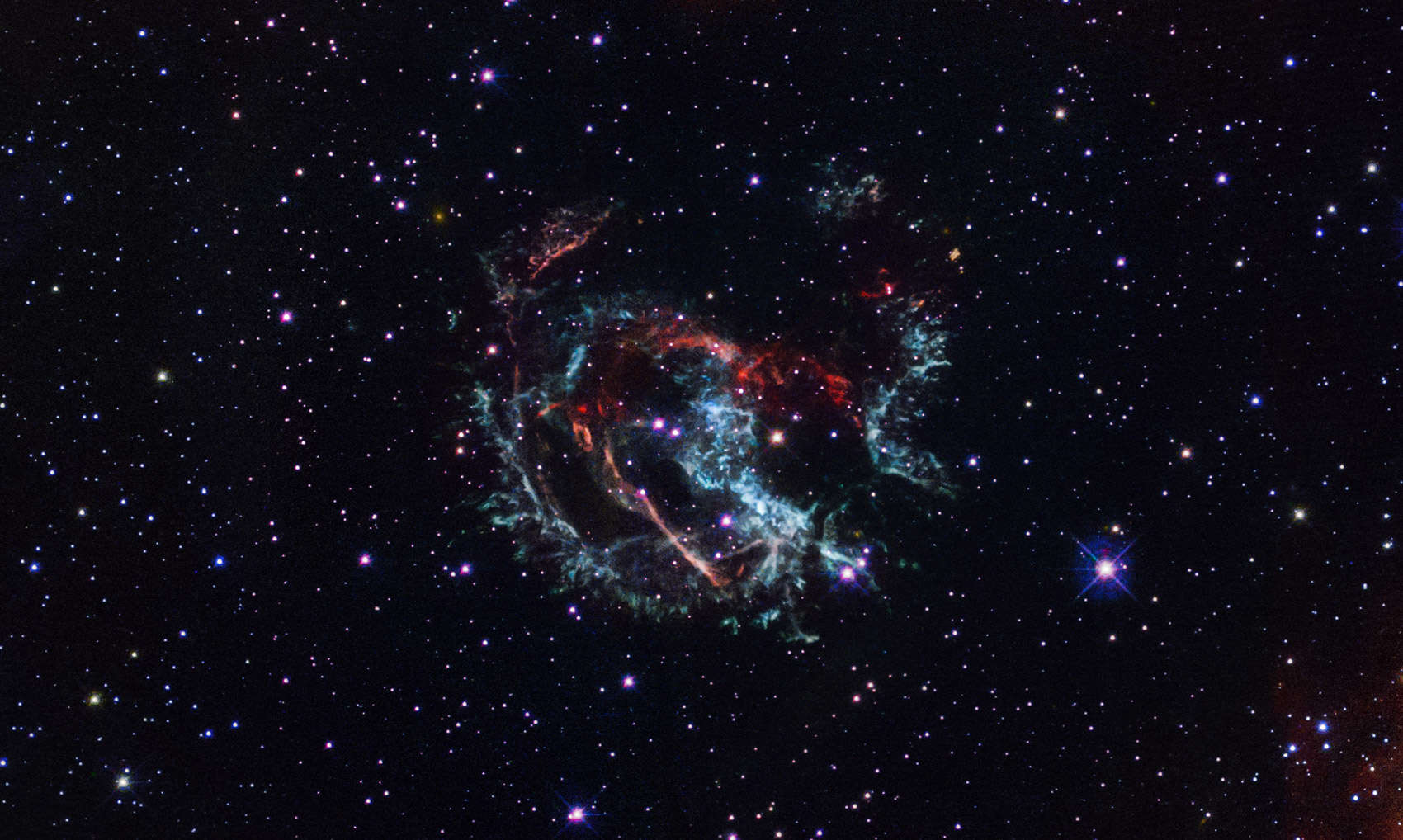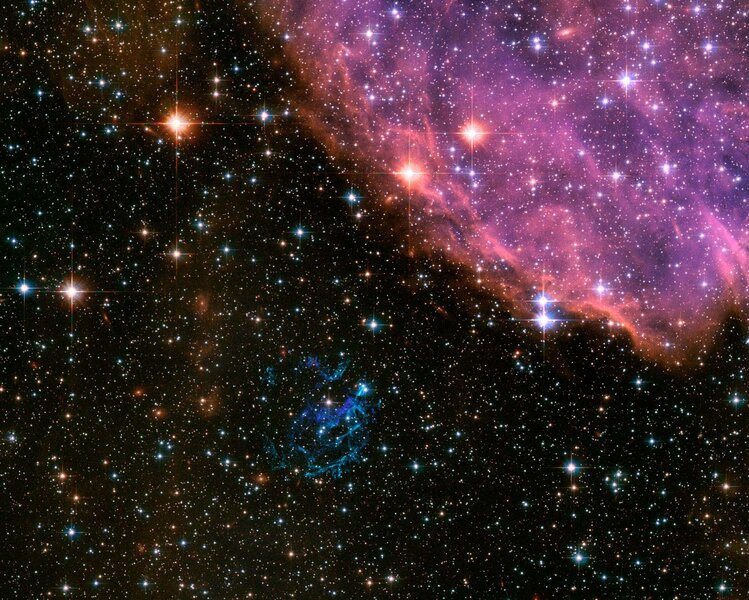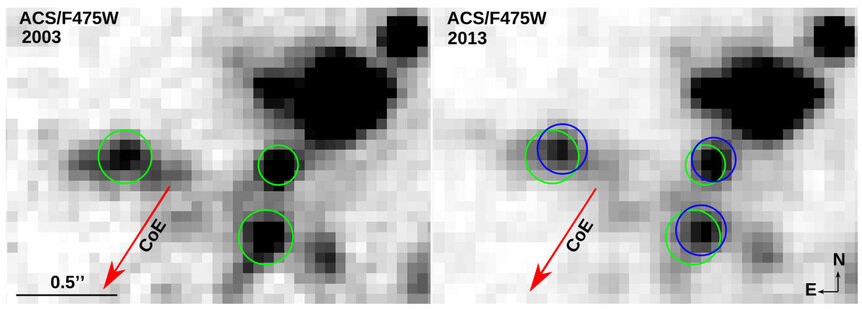Create a free profile to get unlimited access to exclusive videos, sweepstakes, and more!
How do you find when a supernova blew? Run the clock backwards.

About 200,000 years ago, a massive star in a nearby companion galaxy to the Milky Way exploded. Blasting octillions of tons of debris outwards at high velocity, the explosion has been expanding into space ever since. Today it looks like a swirl of cirrus clouds, its huge velocity diminished almost to motionlessness by distance.
But the actual expansion is measurable, and by using a clever technique that runs the clock on it backwards, astronomers have determined when the light of the explosion first reached Earth: 1746 years ago, give or take 175*.
The debris cloud is called 1E 0102.2-7219, and is located in the Small Magellanic Cloud, a dwarf galaxy that orbits the Milky Way. Analysis of the debris indicates it was caused when a star 25 – 50 times the mass of the Sun reached the end of its life, detonating in a colossal supernova.
The debris flies away into space, expanding away from the point of the explosion, some of it moving at well over 2,000 kilometers per second. Even though it's so terribly far away, observations of the supernova remnant (as the debris cloud is called) taken a few years apart can show the physical motion of some of the individual knots of material. This is easier to see in closer supernovae, like, for example, in the Crab Nebula.
And that's just what astronomer have done for 1E 0102.2-7219. Using Hubble Space Telescope, a team of astronomers carefully measured the positions of 22 clumps of material in the remnant in observations taken in 2003 and 2013, noting their motion outwards from the center of the explosion. Once those numbers are in hand, it's possible to turn them around, and calculate when they all met at the center — in other words, how long it's been since the supernova event. That's how they got the age of 1746 years.
It turns out — of course! — it's actually a little more complicated than that. For one thing that age is an upper limit; the explosion may have occurred a bit more recently. That's because space isn't entirely empty. There's gas out there between the stars, and the knots moving outward have to push against it. That slows them down, so when you measure their velocity as you see them now they may not be moving as rapidly as they did in the past. The velocity you put into the math is too low, and you get a higher age than the real one because you think it took them longer to get where they are than it really did.
It also helps to use only knots that are moving the most rapidly. Ones moving slower haven't moved as much, so the change in positions between observations is smaller and harder to measure. Also, ones moving slower may be pushing against more material, so their velocities will mess up the calculation anyway. Out of more than 90 knots found in the images, the team only used the fastest moving 22 to get the age to avoid that issue.
Other astronomers have used various methods to try to get the age of the remnant, but the various methods didn't yield as precise a measurement. One advantage the new observations have is that they were not only based on observations using the same telescope (Hubble) but ones that were done on the same camera. That gives the astronomers a nice stable platform that gives better data. In fact, the team making the observations reported here did try to use older Hubble data to get a longer baseline, but those were done on a different camera and introduced uncertainties that made their calculations worse! So they dropped that idea and stuck to the single camera observations.
They were also able to nail down the spot on the sky the supernova happened. That's important because a massive star explosion like this can leave behind a dense neutron star or even a black hole, and if that can be found it helps astronomers understand the star itself better. As it happens there is an X-ray source located not too far from where they calculate the center of the explosion to be, and both neutron stars and black holes can emit X-rays. However, it's located far enough away from the center (about a light year at least) that they suspect it's actually a knot of gas in the debris cloud itself and not the compact object left behind by the explosion. If anything was left behind, it's unclear what or where it is.
This all raises the question, did anyone see this event back in, oh, 275 A.D. or so? The paper doesn't mention it. The supernova was in the extreme southern part of the sky (-72° celestial latitude) so would've been visible to people living in Australia, South America, and South Africa at the time. It would've been faint, though, so it's possible it went unnoticed. Finding records of it might prove difficult.
Still, this is pretty cool work, and very useful. Understanding the age of a supernova is critical to understanding its dynamics: How the debris moves over time, how that changes, how it interacts with material around it, and much more. The astronomers hope to get another set of observations using the same camera, further nailing down the uncertainties and possibly aiding in finding what might be left over at the center. If that can be found, it will help these measurements a lot.
I've done measurements like this, and it can be very difficult, fraught with subtle issues. This is an impressive piece of work, and as time goes on I expect we'll see more like it using our venerable fleet of orbiting telescopes that afford us such a long baseline of time between observations.
*From what I can tell, the paper uses observations from 2013 as the baseline for the age, which they calculate to be 1738 years. Adding eight years to that to bring it to 2021 makes the age 1746 years, though the uncertainty is so large (175 years) that 8 years doesn't make any real difference. Also, I am ignoring the fact it took the light a couple of hundred thousand years to reach us; the age listed throughout the article is the age since the light first reached us.





























